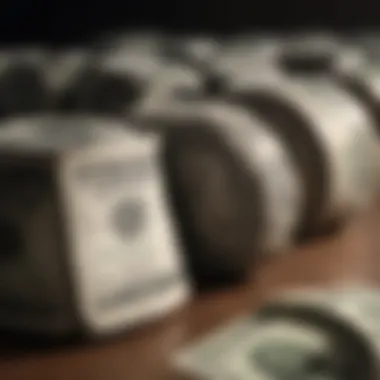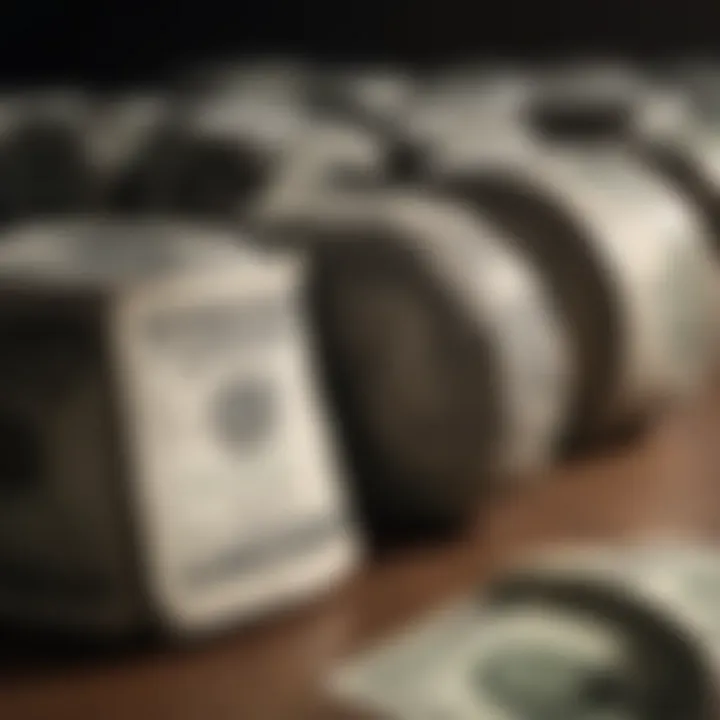Analyzing the US Dollar and Pakistani Rupee Exchange Rate


Intro
The exchange rate between the US Dollar and the Pakistani Rupee is not just a simple number; it's a reflection of broader economic narratives and intricate relationships. As the dollar strengthens or weakens, it sends ripples through the Pakistani economy, impacting everything from consumer prices to investment strategies.
Market players, including investors and consumers, need to keep a pulse on this relationship. Why? Because understanding these fluctuations can hold the key to smart financial decisions. Price changes in imported goods, remittances sent back home, or even the cost of education abroad hinge on the dollar-to-rupee rate. Thus, the stakes are higher than many might realize.
Investment Dictionary
In order to navigate the complexities of currency trading, it's crucial to be familiar with key financial terminology. Let's take a look at some important terms you'll hear when discussing the US Dollar and Pakistani Rupee.
Definition of Key Terms
- Exchange Rate: The price at which one currency can be exchanged for another. This fluctuates based on supply and demand dynamics in the market.
- Devaluation: A reduction in the value of a currency against others. In the case of the Pakistani Rupee, a devaluation can impact import prices and inflation.
- Inflation Rate: A measure of the rate at which the general level of prices for goods and services is rising. When inflation rates vary, they can influence purchasing power relative to the US Dollar.
Explanation of Financial Concepts
Understanding some key financial concepts can also shed light on the exchange relationship:
- Purchasing Power Parity (PPP): This theory suggests that over time, exchange rates should adjust so that identical goods cost the same in different currencies. Disparities can indicate whether a currency is overvalued or undervalued.
- Interest Rate Differential: This refers to the difference in interest rates between two countries. It can attract foreign investment and strengthen a currency. A higher interest rate tends to attract more capital from foreign investors seeking higher returns when holding that currency.
"The exchange rate is a stylish dance between different economies, and one misstep can turn profits into losses."
Tips for Beginner Investors
- Start Slow: Don’t plunge into the markets headfirst. Begin with small amounts and set limits.
- Stay Informed: Regularly follow news related to both the US economy and Pakistan’s fiscal policies. This information can guide your decisions.
- Diversify: Don’t put all your eggs in one basket. Diversifying your investments can minimize risks associated with currency fluctuations.
Advanced Strategies for Seasoned Investors
For those who have been around the block a few times:
- Currency Hedging: Consider using financial instruments like options and futures to protect against adverse movements in exchange rates.
- Analyze Macroeconomic Indicators: Keep an eye on global economic trends, as factors such as trade balances, employment figures, and GDP growth can greatly affect currency values.
- Use Technical Analysis: Familiarize yourself with chart patterns and indicators, as they can help predict future movements in the dollar-rupee exchange rate.
In crafting financial strategies that center around the US Dollar and Pakistani Rupee, both novice and experienced investors should arm themselves with relevant knowledge and insights, weaving a safety net that can withstand economic fluctuations.
Prolusion to Currency Exchange
Currency exchange is the art of determining how much one currency is worth in relation to another. It's a vital process, especially when discussing the US Dollar and the Pakistani Rupee, given the importance of these currencies in global trade and finance. In a world where commerce knows no borders, understanding currency exchange rates is not just for economists; it's something that impacts travelers, investors, and businesses alike.
Grasping the ins and outs of currency exchange can lead to better financial decisions and strategies, whether you're planning a trip or investing in foreign assets. Noteworthily, favorable exchange rates can lead to significant cost savings or additional profits.
Understanding Currency Exchange Rates
Currency exchange rates fluctuate constantly due to a multitude of factors. They can rise or fall based on political events, economic indicators, and sometimes, mere speculation. For example, if the US economy shows signs of growth, the Dollar tends to strengthen against currencies like the Pakistani Rupee. This dynamic relationship can have ramifications for trade, tourism, and investments.
When dealing with exchange rates, it’s important to get familiar with some terms,
- Base currency: The currency you are exchanging from.
- Quote currency: The currency you are exchanging to.
- Bid price: The price you get when selling a currency.
- Ask price: The price you pay when buying a currency.
By understanding these basics, one starts to see how exchange rates can influence matters from purchasing power to overall economic health.
The Role of Currency in the Global Economy
The influence of currency extends far beyond individual transactions. A strong currency—like the Dollar—can increase a country’s purchasing power on the international stage. Conversely, a weaker currency, such as the Pakistani Rupee, may facilitate cheaper exports, making local goods more attractive to foreigners but potentially soaring import costs.
Why does this matter? Because countries often engage in a balancing act. They might want to maintain a competitive edge by adjusting their currency values. Understanding these dynamics helps grasp how the economic landscape operates. Currency is not merely a medium of exchange; it’s a tool of economic strategy.
In the end, a thorough understanding of currency exchange is crucial not just for savvy investors but for anyone who plays in a globally connected economy. As the exchange between the US Dollar and the Pakistani Rupee illustrates, even small fluctuations can have large impacts on business opportunities and everyday life.
Historical Context of the US Dollar and Pakistani Rupee


Understanding the historical context of the US Dollar and Pakistani Rupee is essential for grasping how these two currencies interact and influence each other's value. This backdrop provides valuable insight into economic events, trade relationships, and the overall financial stability of both nations. By dissecting the historical dynamics, we can see how the exchange rates evolve, thereby equipping investors and policymakers with the knowledge to navigate future fluctuations.
Historical Exchange Rates Overview
A glance at the historical exchange rates tell us more than just numbers. The journey of the US Dollar against the Pakistani Rupee has seen significant ups and downs, each telling a story of economic turmoil or stability. For instance, in the early days of Pakistan's independence in 1947, the exchange rate was around 4.76 PKR to 1 USD. Fast forward to the late 1970s, and the Pakistani Rupee had seen a notable depreciation, trading at around 9 to 1 USD. This depreciation can be attributed to several factors like economic shortfalls, inflation rates, and shifting political landscapes.
"The history of currencies is more than just numbers; it reflects the ambitions and anxieties of nations over time."
From the late 1990s to the 2000s, we observed a rapid decline in the Pakistani Rupee’s value. In 2002, the exchange rate reached approximately 60 PKR per USD, reflecting a period of economic challenges in Pakistan, including rising fiscal deficits and weak foreign investment. Although fluctuations have remained a constant over the decades, the steep incline in rates indicates underlying issues that need addressing.
Milestones in Currency Value Changes
Milestones act as markers on the economic timeline. One of the earliest significant events was in 1971 when the devaluation of the PKR took place. This was aimed at bolstering exports but instead led to a broader economic impact that laid the groundwork for future fluctuations.
Another crucial moment came in 2008 when the dollar shot up to around 80 PKR. This was not only a reflection of troubled economic policies but also tied to global financial crises, highlighting the interconnectedness of currencies.
In more recent years, especially from 2018 onward, the PKR experienced a dramatic decline, hitting over 160 PKR against the dollar by 2020. Such rapid changes often stir discussions about monetary policy and governance, indicating that the state of the Pakistani Rupee is not isolated but entwined with broader global and local economic conditions.
These milestones are critical for investors looking to understand where the market stands today and what might come next. Knowing the evaluation path can help businesses, government entities, and individual investors predict potential risks they may face while dealing with these currencies.
Factors Influencing Exchange Rates
Economic Indicators and Their Impact
Economic indicators, such as GDP growth, unemployment rates, and trade balances, act as the compass guiding currency values. For instance, a robust gross domestic product (GDP) growth rate generally signals a thriving economy, often resulting in a stronger currency. In Pakistan, a boost in GDP can lead to greater investor confidence in the Rupee, which may cause its value to stabilize or appreciate against the Dollar. Conversely, high unemployment rates indicate economic distress, undermining the currency's strength.
When assessing the US Dollar, one must also monitor its own economic indicators. A rising trade deficit in the U.S. can lead to a depreciation of the Dollar, making imports more expensive for Pakistani traders. Furthermore, employment data released every month can move markets by affecting perceptions of the U.S. economy's health. Thus, keeping an eye on these indicators is vital for forecasting potential shifts in the Dollar-Rupee exchange rate.
Political Stability and Currency Strength
An often underestimated factor in the world of currencies is the impact of political stability. The political landscape of a country can significantly sway investor confidence and, consequently, its currency. In Pakistan, political uncertainty—be it due to administrative changes or social unrest—can induce foreign investors to pull back, leading to a depreciation of the Rupee. Conversely, stable governance and transparent policy-making often result in a stronger currency, as investors are generally more willing to place their bets.
Take, for instance, major elections or reforms; these events can lead to volatility in exchange rates. If the U.S. faces political turmoil, one can expect fluctuations in the Dollar's value as well. Both countries' policies impact the currency exchange, and the interplay between political events and market psychology is profound.
Inflation and Interest Rates
Inflation levels and interest rates are tightly interwoven, playing a vital role in determining the relationship between the Dollar and the Rupee. High inflation in Pakistan might force policymakers to raise interest rates to combat inflationary pressures. Higher interest rates tend to attract foreign capital, resulting in currency appreciation. Thus, in theory, if Pakistan's interest rates go up in response to inflation, it may lead to a stronger Rupee against the Dollar. However, this is a double-edged sword, as excessively high rates can deter investment, leading to economic decline.
On the flip side, the Federal Reserve's policies in the U.S. also have far-reaching consequences. If the Fed opts to decrease interest rates to stimulate economic growth, it can weaken the Dollar, making foreign currencies, like the Rupee, more attractive. The tug-of-war between inflation and interest rates often leads to substantial currency fluctuations.
"The exchange rate is the price of one currency in terms of another; understanding it requires knowledge of underlying economic principles."
In summary, the factors influencing exchange rates between the US Dollar and the Pakistani Rupee are complex and interconnected. A change in one area often reverberates across the others, requiring traders and investors to stay abreast of all economic, political, and market developments. Adequate understanding of these influences is essential for making informed decisions in both personal finance and international business.
Current Economic Climate and Its Effects
The dynamics between the US dollar and the Pakistani rupee are shaped significantly by the current economic landscape of both the United States and Pakistan. Understanding this relationship becomes especially critical during periods of fluctuation, as it directly impacts trade, investment, and everyday consumer behavior. As various global and local economic factors intertwine, their effects ripple through multiple layers of the economy, making it essential to grasp how these currencies influence one another.
Recent Trends in the Dollar-Pakistani Rupee Exchange Rate
Recent fluctuations in the exchange rate between the US dollar and Pakistani rupee have caught the attention of economists and investors alike. Over the past year, the value of the Pakistani rupee has experienced both peaks and troughs, often reacting to broader economic indicators. For instance, in response to shifts in oil prices or changes in US interest rates, the rupee could depreciate significantly or show resilience.
- Observations:
- The rupee has generally softened against the dollar, reflecting increasing import costs and a trade imbalance.
- A landmark moment occurred when the exchange rate crossed Pakistani Rupee 200 per US dollar, marking a psychological barrier and sparking discussions about fiscal policy reforms.
The impact of these trends can be seen in various sectors, especially in consumer goods where import prices are directly affected. As the rupee weakens, the cost of imported goods rises, thereby creating inflationary pressures that affect purchasing power.
Impacts of Global Events on Currency Value


"Even minor policy changes in Washington can trigger significant reactions in the currency valuation across the globe."
Some significant factors influencing this interaction include:
- US Federal Reserve Decisions: Changes in interest rates by the Fed have a direct influence on the dollar's strength. Higher interest rates typically attract foreign investments, bolstering the dollar at the expense of the rupee.
- Global Supply Chain Issues: Recent disruptions due to the pandemic have hindered supply chains, heightening the costs of imported goods in Pakistan and further straining the rupee's value.
- Political Stability: Political events in Pakistan, such as elections or governmental changes, also play a pivotal role as they can either stabilize or destabilize investor confidence.
All these variables contribute to an interconnected economic reality. Their implications can stretch beyond currency alone, affecting trade balances, investment portfolios, and consumer budgeting. By monitoring these trends, stakeholders can navigate the complexities surrounding the currencies more adeptly.
Implications for Personal and Business Finances
Effects on Import and Export Businesses
In the world of international trade, exchange rates serve as the backbone of pricing strategies. For import businesses in Pakistan, a stronger US Dollar means higher costs for goods priced in dollars, such as machinery, electronics, and even essential raw materials. When the exchange rate swings against the Rupee, these businesses might be left scrambling to adjust their prices to maintain margins or accept reduced profitability. This predicament forces many to either pass on the cost to consumers or look for cheaper alternatives.
Conversely, for export-oriented firms, a weaker Rupee relative to the Dollar can provide a competitive advantage in overseas markets by lowering the effective price for foreign buyers. This scenario can boost sales and enhance profit margins. However, the benefit might be offset if businesses rely on imported materials, creating a complex balancing act.
Key considerations include:
- Cost Structure Adjustments: Importers may need to update their pricing structures frequently, whereas exporters might find a marginal edge with a weaker Rupee.
- Supply Chain Management: Businesses should evaluate their supply chains to mitigate the impact of currency fluctuations. Sourcing locally can sometimes shield firms from international exchange risks.
- Financial Hedging: Firms may want to consider financial instruments designed to hedge against unfavorable exchange movements.
Impacts on Travelers and Remittance
For travelers, understanding the dollar-to-Rupee value is indispensable. Pakistani nationals heading abroad, particularly to the US, will find that a strong dollar makes their expenses considerably higher. From hotels to dining out, costs skyrocket when converting Rupees to Dollars. Therefore, it's prudent for travelers to monitor exchange rates closely before making plans, allowing them to budget effectively and mitigate the impact of currency fluctuations on their trip costs.
Remittances, on the other hand, present a two-fold scenario. Many Pakistani families rely on money sent from relatives residing in the US, and a favorable exchange rate can translate into substantial benefits. A strong Dollar enhances the value of remittances in Rupees. However, this highlights another layer of complexity, as recipients may also face reduced purchasing power in the local economy due to domestic inflation.
In summary, the implications of exchange rates on both personal and business finances are profound:
- Travel Budgets: Travelers need to adapt their financial strategies based on exchange movements to maintain their budgets.
- Remittance Value: Monitoring currency fluctuations can maximize the effectiveness of remittances, ensuring families can meet their needs without feeling the pinch.
- Market Adaptation: Businesses must acclimatize to changing economic landscapes to safeguard their financial health.
*"Currency exchange rates serve as an important tool in navigating the global economy. Understanding them helps everyone from policymakers to individual consumers."
When grappling with these currency dynamics, both personal and organizational strategies must evolve accordingly, highlighting the necessity for continuous market observation and financial planning.
Investment Opportunities in Relation to Currency Fluctuations
Investing in currencies often opens doors to diverse strategies that can yield profitable outcomes. For instance, understanding the volatility between the US Dollar and Pakistani Rupee can allow investors to time their moves wisely. Currency rates aren't set in stone—they ebb and flow with economic indicators, geopolitical events, and market sentiment. Therefore, keeping a close eye on these fluctuations is vital for anyone looking to maximize returns.
Forex Trading Strategies
Forex trading, or foreign exchange trading, revolves around buying and selling currency pairs. It is a market where small movements can equate to substantial gains—or losses. Here are a few strategies tailored specifically for navigating the dollar and rupee relationship:
- Scalping: This involves making rapid trades to capture small price changes. If one observes a slight dip in the rupee against the dollar, buying quickly and selling at a small profit may be feasible.
- Swing Trading: This strategy requires a bit more patience, as it focuses on longer-term trends. For example, if economic indicators suggest a strengthening Pakistani economy, it could be beneficial to buy rupees against dollars in anticipation of future appreciation.
- Risk Management: Effective investors always use stop-loss orders. If the market swings against your position, these orders can safeguard investments, potentially capping losses during unpredictable market behavior.
It’s important to stay updated on events that can impact currency value, such as changes in interest rates, political instability, and global economic shifts.
Investment in Pakistani Assets Amid Exchange Fluctuations
For those considering investments directly within Pakistan, understanding the fluctuations between the dollar and rupee is crucial. A weakening rupee can make local assets cheaper for foreign investors, presenting unique opportunities.
- Real Estate: When the rupee depreciates, foreign buyers often see this as a chance to purchase properties at lower prices. If you’re looking into real estate investments in Pakistan, a weaker rupee means more bang for your buck.
- Stocks: The stock market may also present opportunities. As the rupee drops, many companies may see a boost in profits from exports priced in dollars, potentially leading to increased share prices.
- Bonds: Government bonds may draw attention, particularly when global investors seek stability amid currency fluctuations. If interest rates remain attractive, investing in Pakistani bonds could yield favorable returns.
The Role of Central Banks
Central banks are the backbone of any nation’s economy, wielding significant influence over the strength and stability of a country’s currency. In the context of the US Dollar and the Pakistani Rupee, these banks hold the reins—shaping monetary policies that directly impact exchange rates. Their decisions can ripple across markets, affecting everything from trade balances to inflation rates. Understanding their role can illuminate how foreign exchange operates at a macroeconomic level.
Monetary Policy and Currency Management
The central banks of both the United States and Pakistan play crucial roles in implementing and adjusting monetary policies. The Federal Reserve, for instance, often utilizes tools such as interest rate adjustments and open market operations to control the supply of money. A decision made by the Fed can lead to a stronger US Dollar. Less money circulating usually means that the currency appreciates due to increased scarcity.


On the other hand, the State Bank of Pakistan (SBP) has its own set of strategies aimed at ensuring the stability of the Pakistani Rupee. They might change interest rates to cool down inflation or stimulate economic growth. Higher interest rates can attract foreign investments, thus potentially increasing the value of the rupee. However, these strategies are a double-edged sword; they can also lead to elevated borrowing costs.
Common monetary policy goals for both institutions include:
- Controlling Inflation: Aiming to keep inflation within manageable levels to preserve purchasing power.
- Employment: Striving for a healthy employment rate as jobs boost economic growth.
- Economic Growth: Fostering sustainable economic growth through careful management of the currency supply.
Interventions in Foreign Exchange Markets
When markets fluctuate wildly, central banks may resort to direct intervention to stabilize their currencies, an action often termed as ‘currency intervention’. The Federal Reserve might sell or buy US Dollars to influence exchange rates. For example, if the Rupee is weakening dramatically against the Dollar, it can set alarm bells ringing in the corridors of the SBP.
In such cases, the SBP might step into the market, utilizing its foreign currency reserves to buy Rupees, which seeks to offset excess supply in the market. This type of intervention can help shore up confidence among investors and stabilize prices.
Factors for consideration in interventions include:
- Export competitiveness: A weaker Rupee can boost exports, but too much depreciation might harm long-term economic health.
- Investor confidence: Keeping a stable exchange rate can maintain trust in the financial system.
- Speculation: Unchecked currency movements can lead to speculative trading, which may escalate volatility.
"Central banks must walk a tightrope; balancing the needs of the economy while maintaining currency stability is no easy feat."
By leveraging their position in the financial system, central banks mitigate the risks posed by external economic shocks and ensure that both the US Dollar and Pakistani Rupee maintain their relevance and value in an increasingly interconnected world.
Future Projections and Trends
Understanding the future projections and trends regarding the exchange rate between the US Dollar and the Pakistani Rupee is pivotal for various stakeholders. As the global economy embraces uncertainty, forecasting how these currencies will interact helps in navigating the turbulent waters of finance and trade. Investors, businesses, and consumers alike must keep an eye on potential shifts that might arise from changes in economic policies or market trends.
Forecasting Exchange Rate Movements
When predicting exchange rate movements, several factors come into play. For one, examining historical data can provide context. If we look back, we might see patterns that repeat or shift. Here are some considerations for forecasting:
- Economic Indicators: These can range from GDP growth to employment rates. A robust economy tends to strengthen its currency. If Pakistan’s economy grows steadily, that might signal a stronger Rupee.
- Interest Rates: Central banks play a crucial role here. If the Federal Reserve increases interest rates, it might attract investment in Dollar-denominated assets, thus strengthening the Dollar against the Rupee.
- Geopolitical Events: Any sudden political changes, both in Pakistan and in the US, can send ripples through the currency markets. For instance, an election outcome could impact investor confidence.
It’s worth noting that economists often rely on complex models to forecast these movements. However, the sensitivity of exchange rates means unexpected occurrences can shift the tide overnight.
"Predicting currency movements is as much an art as it is a science."
One critical method often used for forecasting is the Purchasing Power Parity (PPP) theory, which suggests that in the long run, exchange rates should move toward the rate that would equalize the prices of identical goods and services in each country. Yet, day-to-day fluctuations can make this theory seem like a distant advisor.
Potential Economic Reforms and Their Impact
Looking ahead, potential economic reforms in Pakistan hold significant weight in shaping the future landscape of the Rupee. If the government tackles issues related to inflation and trade deficits, we might witness a stabilizing effect on the currency. Here are some reforms that could lead to tangible changes:
- Structural Changes in the Economy: Reforming sectors such as energy and agriculture could lead to increased productivity and, subsequently, a stronger Rupee.
- Trade Agreements: Expanding trade with other countries can increase export earnings, hence providing more strength to the economy and its currency.
- Tax Reforms: Simplifying the tax structure might encourage investment, thus leading to economic growth and improving the valuation of the Rupee against the Dollar.
Such reforms could not only stabilize the Pakistani Rupee but might also elevate the overall trust among investors and enhance trade prospects. Yet, the path to reform often faces challenges, and the measures taken must reflect on practical aspects to foster resilience and integrity in the currency market.
Culmination and Closing Thoughts
In wrapping up our exploration of the connection between the US Dollar and the Pakistani Rupee, it's crystal clear that this relationship is a complex web of economic factors and historical nuances. Understanding how these currencies interact is not just an academic exercise but a tool for making informed decisions, whether you're an investor, a business owner, or an everyday consumer trying to navigate the financial landscape.
One of the most significant takeaways from this discussion is how external influences, from global events to local political stability, shape the values of these currencies. For anyone engaged in trade or investment, staying updated on these elements is essential for strategy development.
Currency values can shift overnight in response to economic news. Keeping abreast of both local and international developments can help situated individuals better prepare for such changes.
Furthermore, the implications for personal and business finances stemming from fluctuations in the dollar-to-Pakistani rupee exchange rate are profound. Importers and exporters, in particular, need to keep an eye on these changes, as they can affect costs and profitability significantly.
When we consider investment opportunities, the landscape is rich with potential. The volatility and trends of the currency exchange open doors for those willing to adopt currency trading strategies. However, it also carries risks that need to be navigated with caution and awareness.
Summarizing Key Findings
To crystallize our discussions:
- The exchange rate reflects more than just numbers; it encapsulates economic health and future expectations.
- Factors influencing the US Dollar and Pakistani Rupee relationship include politics, economic indicators, and even inflation and interest rates.
- For businesses engaged in international trade, strategies should be developed based on the anticipation of currency fluctuations.
- Long-term investors should consider geopolitical risks and economic reforms in Pakistan when building their portfolios.
Final Reflections on Long-Term Trends
As we look to the horizon, the future trends between the US Dollar and the Pakistani Rupee remain contentious. The global economy is unpredictable, and emerging markets like Pakistan can fluctuate based on both domestic pressures and global trends. Future economic reforms could play a crucial role—these adjustments might lead to greater stability or open avenues for growth and investment.
Monitoring advancements in technology and trade agreements should also be part of any serious consideration regarding these currencies. As financial systems evolve, the dynamics will continue to shift, making it all the more critical to keep an ear to the ground.



